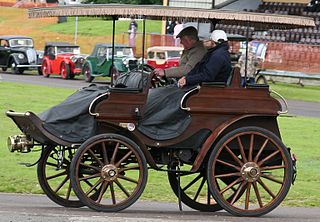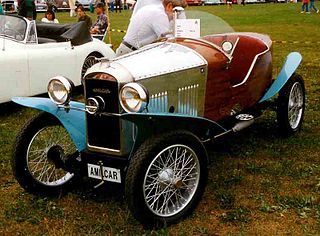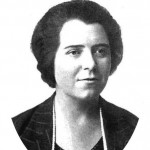
Galloway was a Scottish car maker founded in 1920 as a subsidiary company to Arrol-Johnston. It was based at first at Tongland, Kirkcudbrightshire, and from 1923 at Heathall, Dumfries. It closed in 1928.

Galloway was a Scottish car maker founded in 1920 as a subsidiary company to Arrol-Johnston. It was based at first at Tongland, Kirkcudbrightshire, and from 1923 at Heathall, Dumfries. It closed in 1928.
The company was very unusual in the world of car making in that it was largely run and staffed by women. For a while the cars were advertised as "a car made by ladies for others of their sex". The factory had originally been built as a wartime aero engine plant and Thomas Pullinger, the manager of Arrol-Johnston, was persuaded by his daughter Dorothée Pullinger to keep the factory open to provide local employment. She was made a director of the new enterprise and set up training courses and apprenticeships specifically for local women. The apprenticeships were to last for three rather than the usual five years as the girls were thought to be better at attending and quicker learners than boys. [1]
The factory was near the River Dee and a dam fitted with water turbines was built to provide power, supplemented by a steam engine. It also had two tennis courts on the roof. [1]
The cars were sturdy and straightforward, and a one-model policy was pursued with, at first, the 10/20, which was heavily influenced by the Fiat 501.
It was not, however, a good time to launch a new car, and only a few hundred were made before the Tongland factory was forced to close in 1923 and production moved to the parent works at Heathall, which had plenty of spare capacity. [2] The Tongland factory was later used to make silk.
A second, larger, Galloway model, the 12, essentially an Arrol-Johnston, replaced the 10/20 in 1925 and remained in production until Arrol-Johnston itself closed in 1928 and Galloway Motors was formally wound up. In all a total of around 4,000 Galloway cars were produced. [3] Dorothée and her husband went on to set up, using new American machinery, White Services Laundries Limited in Croydon, which soon had 17 shops. [4]
| Galloway 10/20 | |
|---|---|
 1924 Galloway 10/20 at the annual Biggar Vintage Rally, August 2008 | |
| Overview | |
| Production | 1920–1925 1800 approx produced [5] |
| Powertrain | |
| Engine | 1,460 cc (89 cu in) Straight-4 Side valve |
| Transmission | 3 speed, later 4 speed manual |
| Dimensions | |
| Wheelbase | 102 or 112 in (2,591 or 2,845 mm) [6] |
| Length | 156 in (3,962 mm) [6] |
| Width | 68 in (1,727 mm) [6] |
Designed by T. C. Pullinger from Darracq, Sunbeam and Humber with Fred Neale from Hillman, and heavily influenced by the Fiat 501, the 10/20 used a straight four, side valve engine of 1460 cc driving the rear wheels through either a three or four speed gearbox in unit with the engine. Suspension was by semi elliptic leaf springs at the front and quarter elliptic springs at the rear.
However, the Galloway car had several adaptations to appeal to women drivers. Some, like the introduction of a rear-view mirror and more reliable engine, would be appreciated by all drivers. It was smaller and lighter with more storage space, and the raised seat gave the driver better sight-lines. The hand-brake was situated more conveniently near the driver's seat rather than under the dashboard. [3]
| Galloway 12 | |
|---|---|
| Overview | |
| Production | 1925–1929 (production numbers not known) [5] |
| Powertrain | |
| Engine | 1,669 cc (102 cu in) Straight-4 overhead valve |
| Transmission | 4 speed manual |
| Dimensions | |
| Wheelbase | 114 in (2,896 mm) [6] |
| Length | 156 in (3,962 mm) [6] |
| Width | 68 in (1,727 mm) [6] |
The engine for the 12 (later called the 12/30 and 12/50) was an Arrol-Johnston unit shared with that make's 12 hp model. On test by The Motor magazine a top speed of 51 mph was achieved. Four-wheel brakes were fitted from 1926, and the name was changed from 12 to 12/30. [2] The car was offered for between £325 and £360 depending on body, which was expensive when compared with cars such as Morris and Austin.

ZAZ Zaporozhets was a series of rear-wheel-drive superminis designed and built from 1958 at the ZAZ factory in Soviet Ukraine. Different models of the Zaporozhets, all of which had an air-cooled engine in the rear, were produced until 1994. Since the late 1980s, the final series, 968M, was replaced by the cardinally different ZAZ-1102 Tavria hatchback, which featured a front-wheel drive and a more powerful water-cooled engine.

Arrol-Johnston was an early Scottish manufacturer of automobiles, which operated from 1895 to 1931 and produced the first automobile manufactured in Britain. The company also developed the world's first "off-road" vehicle for the Egyptian government, and another designed to travel on ice and snow for Ernest Shackleton's Nimrod Expedition to the South Pole.

The Aster was an English automobile manufactured from 1922 to 1930. The company's car roots can be traced to 1899 when Begbie Manufacturing of Wembley, in north London became British licensees of the French Aster company making mainly stationary engines. In 1913 they became Aster Engineering Co (1913) Ltd and during World War I made aircraft engines.

Delage was a French luxury automobile and racecar company founded in 1905 by Louis Delâge in Levallois-Perret near Paris; it was acquired by Delahaye in 1935 and ceased operation in 1953.

The Rolls-Royce Phantom was Rolls-Royce's replacement for the original Silver Ghost. Introduced as the New Phantom in 1925, the Phantom had a larger engine than the Silver Ghost and used pushrod-operated overhead valves instead of the Silver Ghost's side valves.
Morris Cowley was a name given to various cars produced by Morris from 1915 to 1958.

Coventry Premier Limited owned a British car and cyclecar manufacturing business based in Coventry from 1912 to 1923. It changed its name from Premier Cycles to Coventry Premier Ltd in November 1914.

Dante Giacosa was an Italian automobile designer and engineer responsible for a range of Italian automobile designs — and for refining the front-wheel drive layout to an industry-standard configuration.

The Leyland Eight was a luxury car produced by Leyland Motors from 1920 to 1923.

The Fiat 519 was a model of car produced by Italian automotive company, Fiat between 1922 and 1927.

The Amilcar C4 is a light sporting car designed for road use made between 1922 and 1929 by the French Amilcar company. The C4 is one of three models introduced by Amilcar in 1922; the others were the CC and the CS, both of which were significantly different from the C4, although they did use the same chassis. The C4 was touted as a more economical and usable vehicle than the other more sporty models. The C4, publicly introduced at the Paris Salon, was offered in three models: the highest-produced was the "Torpedo", which was offered in full Torpedo style or slightly toned down ; both were available configured with 2, 3 or 4 seats. Also available were a sedan, and a commercial version.

The Rolls-Royce Twenty built between 1922 and 1929 was Rolls-Royce's "small car" for the 1920s and was produced alongside the 40/50 Silver Ghost and the successor to the 40/50, the Phantom. It was intended to appeal to owner-drivers but many were sold to customers with chauffeurs.
Arrol-Aster was a British car maker founded in 1927 when Arrol-Johnston and the English Aster company merged. The Wembley, London works of Aster was closed and production concentrated at the Heathhall, Dumfries factory of Arrol-Johnston.

The Fiat 1500 was a six-cylinder car produced by the Fiat from 1935 to 1950. It was one of the first cars tested in a wind tunnel, following the Chrysler Airflow produced one year earlier. The streamlined styling achieved an aerodynamic efficiency unequalled before it in a touring car and disproved the thesis aerodynamic cars would not sell.
The Newton-Bennett was a car advertised and sold by a Manchester, England, based company between 1911 and 1925, but made in Italy.

Dorothée Aurélie Marianne Pullinger, MBE was a pioneering automobile engineer and businesswoman.
Beardmore-Halford-Pullinger (BHP) were a series of aircraft engines used in production between 1916 and 1918. The engines were used on many notable First World War aircraft, such as the Airco DH.4, DH.9, Airco DH.10 Amiens, de Havilland DH.15 and Avro 529 aircraft.

The Chevrolet Series AC International is an American vehicle manufactured by Chevrolet in 1929 to replace the 1928 Series AB National. In all, 1,328,605 Series ACs were manufactured in a range of ten body styles, with 73,918 from Oshawa. The Series AC was the first introduction of the overhead valve Chevrolet straight-6 engine since the 1915 Chevrolet Series C Classic Six, and was advertised as "A Six in the price range of the Four", and was only $10 more than the outgoing four-cylinder Series AB. To simplify production operations, each factory was designated one body style for national consumption and shipped by railroad to major American cities. The serial number of origin was relocated to the right body sill underneath the rubber floormat except for the roadster and phaeton, which were inscribed on the right side of seat frame. Prices listed started at US$525 for the roadster or phaeton to US$725 for the Landau Convertible.

The Alvis 10/30 is a car introduced by British car maker Alvis Car and Engineering Company Ltd in 1920. It was the company's first production vehicle and was made until 1923. A range of body styles was available.
Thomas Charles Willis Pullinger CBE OBE OBK JP was an English automobile engineer. He began his career working with bicycles before the first cars were built. After working for Sunbeam and Humber, he helped expand the Scottish works of Arrol-Johnston, where he developed structured apprenticeship programmes and an engineering college for women.